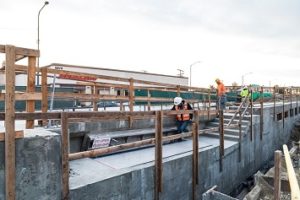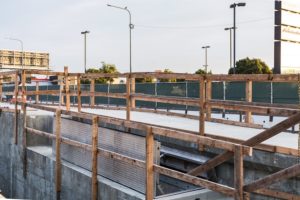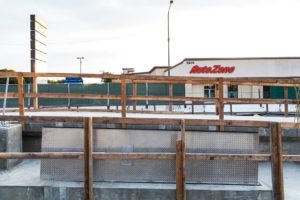Providing code compliant egress is essential for any construction architect but particularly in the case of underground transit systems. The confined spaces, tight stair wells, and potential for the emergency evacuation of hundreds, if not thousands, of riders means the project must be well-designed and constructed.
It’s also essential, however, that egress products function as designed. It’s not only critical for passengers, but also for workers who are building the underground stations. Providing emergency egress for both was one of the top concerns for construction teams building a new rail line in Los Angeles, which will include three underground stations. Three at-grade stations will also include emergency doors to allow access to underground control stations.
The Los Angeles County Metro Rail System and Walsh/Shea Corridor Constructors, which is building the line, used specialty access doors manufactured by The BILCO Company of New Haven, Connecticut, to comply with the fire code egress laws. The project was specified with six emergency exit hatches and four large doors to access the underground control systems. The hatches and doors are installed all along the lengthy project, which is expected to be complete in October of 2019.
“Working underground is a very dangerous job,’’ said Dave Pebley of Specialty Building Components, The BILCO Company sales representative in Pico Rivera, California. “The first thing an underground worker wants to know is how to get above ground quickly in the event of an emergency.”
Plans for the 8.5-mile, $2.058 billion rail line started shortly after the Los Angeles riots in 1992, and the extension is designed to better serve transit-dependent residents in the corridor and provide economic stimulus in the region. Planning started shortly after the Los Angeles riots in 1992 and the extension is designed to better serve transit-dependent residents in the corridor and provide economic stimulus in the region.
Doors Designed for Safe Egress
The doors are equipped with custom features that make them ideal for use in this application. Each of these heavy doors is supplied with an engineered lift assistance system and a two-point panic locking mechanism that allow the doors to open with less than 30-pounds of force, a critical requirement for safe egress in an emergency.
Additional features also need to be added at the ground level where the doors will be installed in sidewalks to ensure reliability and added safety. To prevent structural damage, the doors are reinforced for vehicular loading to withstand the weight of an occasional car or truck that may drive onto the sidewalk. They also feature a slip resistant coating on the walking surface to ensure safety in these high pedestrian traffic areas.
Two emergency doors are at underground stations at Expo/Crenshaw, Martin Luther King, and Leimert Park. The stations at Hyde Park, Fairview Heights, Downtown Inglewood, and Westchester/Veterans are at-grade and the Aviation/Century stop is elevated, so emergency evacuation doors are not required.
Complying with the Code
Compliance for underground egress falls under two key codes from the National Fire Protection Association. NFPA 101, Life Safety Code, characterizes platforms and stations as assembly occupancies, with provisions requiring egress systems that facilitate rapid and efficient evacuation, according to an article in the NFPA Journal.
That code works with NFPA 130, Fixed Guideway Transit and Passenger Rail Systems, which specifies fire protection and life safety requirements for underground, surface, and elevated fixed guideway transit and passenger rail systems. The code includes guidelines on fire protection requirements and emergency ventilation systems.
The egress systems also support workers who are constructing the line. Construction is the most dangerous job in the United States according to statistics compiled by the Occupational Safety and Health Administration. The federal agency reported 4,836 workers were killed on the job in 2015, an average of more than 93 per week or 13 deaths every day. More than 21 percent of the deaths in the private sector occurred in the construction industry, and 10 percent of construction workers are injured every year.
Danger Working Underground
Underground construction is especially dangerous. In 1997, a worker was killed in the construction of a different Los Angeles project when he was pinned against a subway tunnel. In a 1994 fatality in Los Angeles, a man suffered burns over 90 percent of his body when an acetylene tank exploded while working in a subway tunnel. Work on the Crenshaw Line was even suspended for 4 days in 2015 after transportation officials saw a series of safety violations.
“Workers know that with those doors in place, they will be able to get out quickly in the event of an emergency,’’ Pebley said. “The other important consideration is back injuries. They’re not going to produce excess strain on an underground or utility worker. They’re easy to open and close, and they fit well.”
The Importance of Egress
Providing code-compliant egress for passengers seems to have become more critical in the past decade. Decaying infrastructure and terrorist attacks have made underground transportation particularly hazardous, and having safe egress is a concern for transportation officials everywhere.
Like most other aging infrastructure in the United States, inadequate maintenance and costly repairs have taken their toll on underground transportation. In 2015, riders of Washington D.C.’s Metrorail system subway stopped because of smoke in a tunnel. Smoke seeped into the cars, one woman died, and 91 people were injured. The cause of the smoke, according to the National Transit Safety Board, was a fire triggered by electrical arcing from a high-voltage rail. The NTSB said the short circuit had gone undetected and unrepaired.
Last year in New York, the subway system stopped twice in 1 day due to track fires. Many of the issues are related to trash on the tracks. New York’s Metropolitan Transportation Authority removes nearly 40 tons of garbage daily from the intricate system, which covers 245 miles across 36 lines and opened in 1904. In 2015, the MTA reported a staggering 525 track fires throughout its subway system. More than half of the fires, 329, involved debris, grease, and garbage.
Terrorism also threatens subway riders. The deadliest assault occurred in London on July 7, 2005, when a series of coordinated terrorist attacks killed 52 people and injured more than 700. The tragedy was the first-ever Islamic suicide attack on Britain. “Let no one be in doubt,’’ England’s Prime Minister, Tony Blair, said after the bombings. “The rules of the game have changed.”
Since the London tragedy, there have been more than 15 attacks worldwide, including a blast in 2016 in Belgium that killed 20 people. Potential attacks on U.S. soil in New York (2009) and Washington (2010) were foiled.
Updating Infrastructure in Los Angeles
The Los Angeles project is part of a major infrastructure update in advance of the 2028 Summer Olympics. The new projects are designed to increase the use of public transportation and ease congestion on the city’s roadways. The city of Angels is also building a 9-mile extension to a Westside subway line and an automated people mover that will serve people on the Crenshaw Line and help them connect to the broader Metro rail network.
While much-needed and anticipated, rider and worker safety are of critical importance to the project. Pebley feels the Metro Rail Line and Walsh/Shea did their due diligence in taking the proper precautions. “These doors work easily and are very reliable,’’ Pebley said. “The owner of the project took the safety of the workers and the riders into consideration very early on. They understood that in a project like this, safety is paramount.”
 Steve Weyel is a product manager with The BILCO Company and has worked extensively with project managers in the U.S. construction industry to find solutions for their project needs. Steve Weyel is a product manager with The BILCO Company and has worked extensively with project managers in the U.S. construction industry to find solutions for their project needs. |





